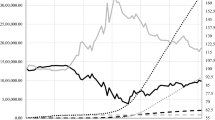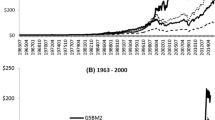Abstract
This study explored the transitional behavior among value and growth stocks based on a balanced panel comprising 520 firms from small-cap S&P 600, mid-cap S&P 400, and large-cap S&P 500 companies during 1999–2008. By employing the nonlinear panel smooth transition regression model, we determined that the annual market-adjusted stock returns were positively related to contemporaneous changes in earnings per share and total asset growth rates and negatively related to the log-transformed 1-year lagged price-to-book equity ratio (LP/B) using the log-transformed 1-year lagged market equity as a transition variable. Our empirical findings are consistent with those by Lakonishok et al. (J Finance 49:1541–1578, 1994), who hypothesized that investors overreact to past firm performance, and Fama and French (Finance Anal J 63:48–58, 2007a, Finance Anal J 63:44–54, 2007b), who discussed the converging P/B ratios caused by the mean reversion in growth, profitability, and expected returns. The three transitional determinants are critical to describing the transitional behavior among value and growth stocks. Moreover, our empirical results indicated that a threshold value of the log-transformed 1-year lagged market equity exists, separating the sample into two groups: value and growth stocks. In addition, the robust test confirmed that the value stocks obtained higher market-adjusted returns during out-of-sample years from 2009 to 2012. These findings have far-reaching implications for institutional investors when creating a profitable and effective investment strategy, and also for CEOs of S&P companies when investing to maximize firm value.

Similar content being viewed by others
Notes
The empirical evidence supporting asset expansion includes acquisitions (Loughran and Vijh 1997; Rau and Vermaelen 1998), public equity offerings (Ibbotson 1975; Loughran and Ritter 1995), public debt offerings (Spiess and Affleck-Graves 1999) and bank loan initiations (Billet et al. 2006). Supporting references from asset contraction comprise spinoffs (McConnell and Ovtchinnikov 2004), share repurchases (Ikenberry et al. 1995), debt prepayments (Affleck-Graves and Miller 2003), and dividend initiations (Michaely et al. 1995).
References
Anderson CW, Garcia-Feijoo L (2006) Empirical evidence on capital investment, growth options, and security returns. J Finance 61:171–194
Affleck-Graves J, Miller RE (2003) The information content of calls of debt: evidence from long-run stock returns. J Finance Res 26:421–447
Bauman W, Conover C, Miller R (2001) The performance of growth stocks and value stocks in the Pacific Basin. Rev Pac Basin Finance Mark Polic 4(2):95–108
Best R, Hodges C, Yoder J (2006) Expected earnings growth and portfolio performance. Rev Quant Finance Account 26:431–437
Billet M, Flannery M, Garfinkel J (2006) Are bank loans special? Evidence on the post-announcement performance of bank borrowers. J Finance Quant Anal 41:733–752
Carlson M, Fisher A, Giammarino R (2004) Corporate investment and asset price dynamics: implications for the cross-section of returns. J Finance 59:2577–2603
Chen C, Lung P, Wang F (2009) Mispricing and the cross-section of stock returns. Rev Quant Finance Account 32:317–349
Choi I (2001) Unit root tests for panel data. J Int Money Finance 20:249–272
Cooper I (2006) Asset pricing implications of nonconvex adjustment costs and irreversibility of investment. J Finance 61:139–170
Cooper M, Gulen H, Schill M (2008) Asset growth and the cross-section of stock returns. J Finance 68:1609–1651
Fama E, French K (2007a) Migration. Finance Anal J 63:48–58
Fama E, French K (2007b) The anatomy of value and growth stock returns. Finance Anal J 63:44–54
Fama E, French K (2008) Dissecting anomalies. J Finance 63:1653–1678
Gomes J, Kogan L, Zhang L (2003) Equilibrium cross-section of returns. J Polit Econ 111:693–732
González A, Teräsvirta T, van Dijk D (2005) Panel smooth transition regression models. Research Paper Series 165, Quantitative Finance Research Centre, University of Technology, Sydney
Granger C, Teräsvirta T (1993) Modelling nonlinear economic relationships. Oxford University Press, Oxford
Hansen BE (1999) Threshold effects in non-dynamic panels: estimation, testing and inference. J Econom 93:345–368
Ibbotson R (1975) Price performance of common stock new issues. J Finance Econ 3:235–272
Jansen ES, Teräsvirta T (1996) Testing parameter constancy and super exogeneity in econometric equation. Oxford Bull Econ Stat 58:735–763
Lakonishok J, Shleifer A, Vishny R (1994) Contrarian investment, extrapolation, and risk. J Finance 49:1541–1578
Li L, Livdan D, Zhang L (2006) Optimal market timing. Working paper 12014, NBER working paper series
Liu L, Whited T, Zhang L (2009) Investment-based expected stock returns. J Polit Econ 117:1105–1139
Loughran T, Ritter J (1995) The new issues puzzle. J Finance 50:23–52
Loughran T, Vijh A (1997) Do long-term shareholders benefit from corporate acquisitions? J Finance 52:1765–1790
Maddala GS, Wu S (1999) A comparative study of unit root tests with panel data and a new simple test. Oxford Bull Econ Stat 61:631–652
McConnell J, Ovtchinnikov A (2004) Predictability of long-term spinoff returns. J Invest Manag 2(3):35–44
Michaely R, Thaler R, Womack K (1995) Price reactions to dividend initiations and omissions: overreaction or drift? J Finance 50:573–608
Miller M, Modigliani F (1961) Dividend policy, growth, and the valuation of shares. J Bus 34:411–433
Myers S (1977) Determinants of corporate borrowing. J Finance Econ 5:147–175
Rau R, Vermaelen T (1998) Glamour, value and the post-acquisition performance of acquiring firms. J Finance Econ 49:223–253
Spiess K, Affleck-Graves J (1999) The long-run performance of stock returns following debt offerings. J Finance Econ 54:45–73
Terasvirta T (1994) Specification, estimation, and evaluation of smooth transition autoregressive models. J Am Stat Assoc 89(425):208–218
Titman S, Wei KC, Xie F (2004) Capital investments and stock returns. J Finance Quant Anal 39:677–700
Vuolteenaho T (2002) What drives firm-level stock returns? J Finance 57:233–264
Zhang G (2000) Accounting information, capital investment decisions, and equity valuation: theory and empirical implications. J Account Res 38:271–295
Zhang L (2005) The value premium. J Finance 60:67–103
Acknowledgments
The author thanks the editor (Prof. Cheng-few Lee) and anonymous reviewers for their helpful comments and valuable suggestions.
Author information
Authors and Affiliations
Corresponding author
Rights and permissions
About this article
Cite this article
Chiang, G. Exploring the transitional behavior among value and growth stocks. Rev Quant Finan Acc 47, 543–563 (2016). https://doi.org/10.1007/s11156-015-0511-7
Published:
Issue Date:
DOI: https://doi.org/10.1007/s11156-015-0511-7
Keywords
- Market-adjusted stock return
- Change in EPS
- Total asset growth rate
- Price-to-book equity ratio
- Market equity
- Investment opportunity




